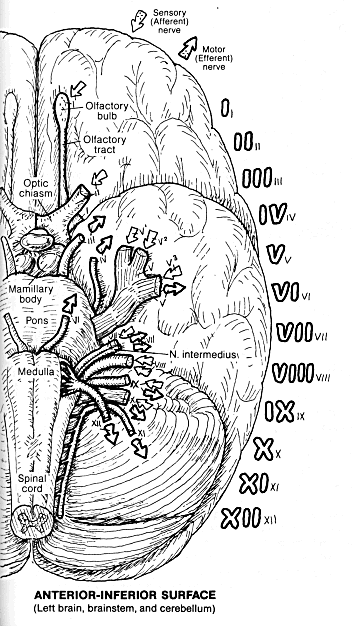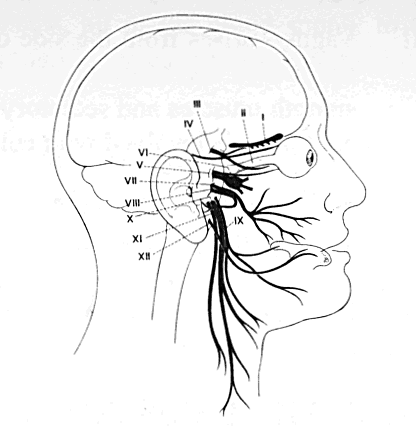A Glimpse of the Brain (c) 2001 Acoustic Neuroma Association This shows some of the complexity of the brainstem, and why the pressure from a tumor affects what it does.

- Olfactory-enters the undersurface of the medial (middle) frontal part of the cerebral hemispheres. It carries sensation from the nose to the brain.
- Optic--enters the undersurface of the medial midportion of the cerebral hemispheres. It carries visual impulses from the retina to the brain.
- Oculomotor-arises from the side of the mid-brain and supplies four of the six muscles that move the eye and the muscle that elevates the eyelid.
- Trochlear-arises from the mid-brain and supplies one muscle that moves the eye.
- Trigeminal--enters the side of the pons and carries sensation from the inside of the mouth, teeth,anterior aspect of the tongue, and skin of the face; supplies the muscles of the jaw.
- Abducens-arises from the anterior (front portion) pons and supplies one muscle that moves the eye.
- Facial-arises from the side of the pons and supplies the muscles that move the face and the lacrimal and salivary glands and carries taste sensation from the anterior tongue.
- Auditory-enters the side of the pons and consists of two parts: the cochlear nerve which carries hearing and the vestibular nerve which transmits impulses from the semicircular canals which affect balance.
- Glossophyaryngeal-arises from the side of the medulla and supplies the parotid gland and carries taste sensation from the posterior third of the tongue.
- Vagus-arises from the side of the medulla and supplies muscles of the vocal cord and those involved with swallowing; gives motor function to smooth muscles and secretory glands in the respiratory and gastrointestinal tracts; is involved with control of cardiac function.
- Accessory-arises from the lower medulla and upper cervical spinal cord and supplies muscles that elevate the shoulder.
- Hypoglossal-arises from the lower medulla and supplies muscles which move the tongue.
ANATOMIC BASIS FOR ACOUSTIC NEUROMA SYMPTOMS

The acoustic neuroma starts near this opening and grows into the canal, which may cause it to enlarge from pressure. The tumor also may extend into the cranial cavity.
The tumor originates in the Schwann cells which form the (electrical insulation) sheath around the vestibular part of the eighth cranial nerve. (Hence the technically correct name for the tumor of Vestibular Schwannoma) As the tumor grows, it interferes with the function of the vestibular and cochlear (hearing) nerves. When the tumor becomes larger, it starts to compress the brain stem and fifth cranial nerve. A very large tumor may involve cranial nerves IV to X and markedly compress the brain stem and cerebellum.
Cranial nerves I, II, III, and XII are usually not involved with the tumor. The eleventh cranial nerve may rarely be involved with large tumors. Functions of the cerebral hemispheres are affected only in the rare circumstances when hydrocephalus (enlargement of the ventricles containing the cerebrospinal fluid) occurs due to obstruction of the normal circulation of the fluid.